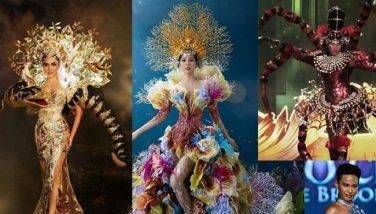Weaving the threads of our identity

Last Feb. 21 to 28, 57 weavers and artisans from 14 provinces and different communities across Luzon, the Visayas and Mindanao, as well as Philippine fashion designers, textile designers, textile experts and advocates of preservation of Philippine cultural heritage, came together at the Philippine International Convention Center for “Likha,” an exhibition and workshop on the Philippines’ traditional and indigenous weaves and textiles spearheaded by the Office of the First Lady, Marie Louise “Liza” Araneta Marcos, in partnership with the Tourism Promotions Board Philippines.
First Lady Liza Marcos is a staunch supporter of Philippine culture and heritage preservation and I am thrilled that she is taking the lead in not just ensuring that our Philippine weaves and the handloom traditions are kept alive but that they continue to thrive amidst a competitive global textile industry.
There is some difficulty in sustaining the weaving industry due to certain reasons: the weavers are getting older and some of those who know the patterns have passed away, less and less of the younger generation are willing to learn the difficult process and complicated patterns, and some of them lack the discipline and patience that is required of the craft. This is compounded by the scarcity of raw materials like handspun cotton thread, natural fibers and vegetable and plant dyes – thus our fear that the weaving tradition is dying is becoming more real.
Likha is a proactive response to this looming problem. It created a venue for traditional weaving communities to connect with manufacturers, designers and brands in crafting a sustainable pathway for Philippines textiles. For one week, the stakeholders from different communities all over the Philippines came together to share knowledge, experiences and best practices in weaving, manufacturing and marketing as well as purposeful innovation and new design applications to not only aid the participating local weavers in gaining a greater presence in the textile market but also for the weavers to educate the rest of us about the context and meaning behind these cultural properties.
The weavers received training and learning sessions from top contributors in culture, art, design and manufacturing and they were also mentored by textile experts to explore opportunities in improving their products and weaving processes. But through all of these, the central figure of the Likha are the weavers. First Lady Liza Marcos was intent on honoring our local weavers and celebrating the weaving tradition of the Philippines. It is about listening to their stories, being sensitive to their needs and adopting a perspective that would allow for an empathetic empowerment of our local weavers towards purposeful innovation.
I was able to catch Likha on its last day and I went there excited to see the different weaves that were exhibited and to purchase some of them too. I was awed by the skill of the weavers and how effortlessly they went about inserting individual threads to make an intricate pattern that required absolute precision to be able to execute perfectly. I learned about what the patterns symbolize and on what occasions they are worn and by whom.
While admiring one of the Ifugao woven textiles, I learned from the weaver and Charisse Tugade from CulturAid, an organization that promotes indigenous community empowerment, that some of the textiles are only to be worn by the tribal chief or on certain rites and special occasions. One Ifugao weave in particular, the ga’mong, is a funerary blanket used only for the dead. The ga’mong is not to be used by the living but many do not know this and that is why it was previously used to make dresses or shoes by some designers.
I realized then that I did not know much about the different weaves that I have been wearing for years. I was proud to wear these different weaves and proud of our rich and diverse culture but I did not even know the proper name for all the weaves, what some of the patterns are called, what many of them symbolized and on what occasion they should be worn or whether they are supposed to be worn in the first place. There was an apparent disconnect and I vowed to correct it.
Pride in our culture is founded on knowing our culture. How can one claim to love our rich heritage without knowing and understanding the history and meaning behind our inherited traditions, objects, monuments, art and culture? When we wear and use our local weaves we should give importance to the history behind it, and the meaning and the makers behind them. The local woven textiles are pleasing to the eye and they have become very fashionable to wear, but what makes our Philippine indigenous textiles truly beautiful are the stories, the people and the meaning behind them. Knowing and understanding these give us a proper and meaningful appreciation for the indigenous textiles. This is a way of giving respect to the weavers and the communities where they are from and of showing our love for our culture and heritage.
Through Likha, our First Lady Liza Marcos does exactly that. She highlights the cultural significance of our local weaves and puts the weavers front and center. She is dedicated to empowering Philippine local weaving communities through cultural and economic programs that help preserve these valuable traditions while building opportunities for sustainable community development. And this is much appreciated by the weavers. Their gratitude to and love for our First Lady was evident when at the last day of Likha they praised her for her efforts and even prepared a song and dance number for her.
The weavers were also very happy that they were given the opportunity to upgrade their textiles; have learning sessions from top contributors in art, design and manufacturing and to connect with different manufacturers, designers and brands with a view to forging a sustainable pathway for Philippines textiles.
Through the indigenous weaving tradition we see our rich, unique and diverse culture as well as the resilient, creative and talented people that created them. Through the different weaves produced by the hundreds of weaving communities from Luzon, the Visayas and Mindanao we see the threads of our common history, experiences, heritage, culture and love for our country that bind us together and unite us all.
- Latest
- Trending





























